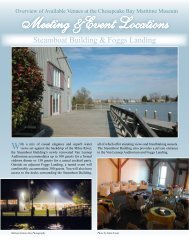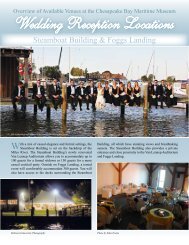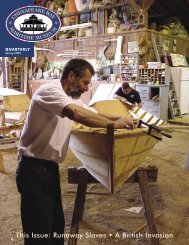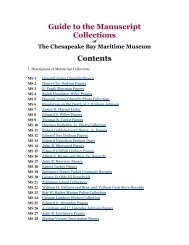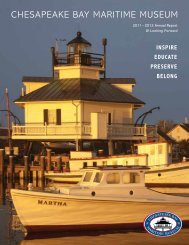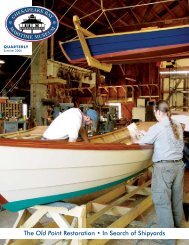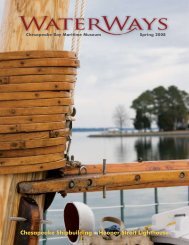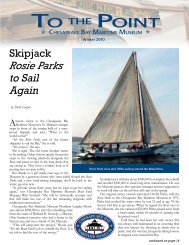Fall 2008 - Chesapeake Bay Maritime Museum
Fall 2008 - Chesapeake Bay Maritime Museum
Fall 2008 - Chesapeake Bay Maritime Museum
Create successful ePaper yourself
Turn your PDF publications into a flip-book with our unique Google optimized e-Paper software.
20<br />
Maple Hall in Claiborne, Md., is one of the most dominant<br />
architectural presences in a town that today has fewer than<br />
150 full-time residents.<br />
In the attic of Maple Hall, the rambling old manor house that<br />
has served as a guest house since the late 1800s, there is a chest<br />
that contains a tangle of shirts, papers and ledgers. They are all<br />
the remaining earthly goods of Charles “Carroll” Cockey.<br />
Uncle Carroll’s headstone in the family plot down by the<br />
banks of Tilghman Creek marks his life simply as “1876-<br />
1943,” but stories about him continue to be told.<br />
He was an epileptic at a time when the neurological disorder<br />
was viewed with more fear than understanding. Every<br />
summer, for much of his life, he was sent off to a home in<br />
Easton so his seizures would not terrify guests at the inn. But<br />
most of the time, he was a “gentle giant” who was well over<br />
six feet tall and known for his strength.<br />
Penny says that one family story has Cockey at the scene<br />
of an accident where a man had been changing the wheel on<br />
a wagon when the wagon fell on him.<br />
“He picked up the wagon and saved the man.”<br />
In another story, Cockey was walking across a field on<br />
nearby Rich Neck when a bull chased him. Cockey sidestepped<br />
the bull and pulled its tail out.<br />
“I am sure that the farmer was not pleased to lose a prized<br />
bull that way but that again is a folk tale among the many<br />
stories that have been handed down forever.”<br />
Maple Hall has long been one of the dominate buildings<br />
in Claiborne. The village today is a quiet hamlet of less than<br />
150 residents and a post office. But 100 years ago, it was the<br />
hub of ferryboat and rail commerce. Named for William Claiborne,<br />
who settled Kent Island across Eastern <strong>Bay</strong> in 1631,<br />
the village is actually the second development on the peninsula<br />
bounded by Eastern <strong>Bay</strong> and the Miles River, just five<br />
miles northwest of St. Michaels.<br />
The Tunis family operated a steam-driven lumber mill in<br />
what is now Old Claiborne at the head of Tilghman Creek, as<br />
well as a mill across the Miles River and up Leeds Creek in the<br />
community of Tunis Mills. They also had mills on the Elizabeth<br />
River in Norfolk, Va., and in Tunis, N.C.<br />
The Tunis business journals and correspondence covering<br />
decades of transactions are stored in various locations at<br />
Maple Hall.<br />
In the 1880s, Joseph Tunis had big plans for the land<br />
around the Tilghman Creek mill. He named it <strong>Bay</strong> City, laid<br />
out a crosshatch of streets, and subdivided it into 188 lots for<br />
sale. It was hoped that it would rival <strong>Bay</strong> Ridge, the popular<br />
resort across the <strong>Chesapeake</strong>, east of Annapolis that was<br />
started in 1879 and was all the rage in the late 1800s.<br />
The plan shows the community centered around Henry Clay<br />
Square, with a commercial core surrounded by snug residential<br />
lots. It may have made sense at the time, but it never developed<br />
past a small collection of houses, mainly for the workers at<br />
the sawmill, oyster house and shipyard that lined the edge of<br />
Tilghman Creek. A few of those houses still stand along Old<br />
Claiborne Road, a half-mile south of the current village.<br />
Rick and Penny Rhine own and operate Maple Hall Inn as a<br />
bed and breakfast, which they call “a Shore tradition.”



